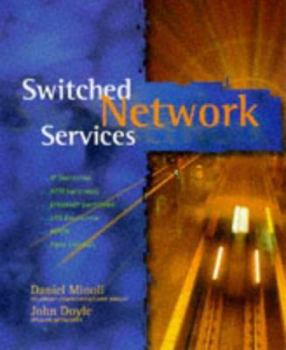Switched Network Services
An expert guide to the high-speed switching and routing options of today and tomorrow. Network Layer Switched Services provides advanced network planners with vital information on switched data... This description may be from another edition of this product.
Format:Hardcover
Language:English
ISBN:0471190802
ISBN13:9780471190806
Release Date:March 1998
Publisher:Wiley
Length:384 Pages
Weight:1.92 lbs.
Dimensions:1.1" x 7.7" x 9.5"
Customer Reviews
1 rating
ATM, LANE and MPOA primer (despite of the title)
Published by Thriftbooks.com User , 23 years ago
The publication provides in eight quite independent chapters much broader (sometimes surprising) range of topics than its title suggests. After the introductory chapter similar to 80-page executive overview covering all what follows (including an extensive description of I/O technologies), the actual topics for discussion start at layer 2 LAN bridging and switching (with an overview of standard LANs principles, stopping very briefly at still advancing gigabit local networks and VLANs). Next chapter moves into the wide area deeply discussing the ATM principles and switching. The following two chapters are dedicated first to the deployment of the ATM for IP carriage, IETF's solution for classical IP over ATM (CIOA), and second to the support of LAN native services across the ATM network, the ATM Forum's LAN emulation (LANE) and its advanced ancestor, multiprotocol over ATM (MPOA). Both ATM basics and communication of various types across the network are very well explained and described. What is very appreciable is the clear distinction among the three de facto standards, putting their deployment in right perspective and in comparison even through repeating the main features several times throughout the chapter. To briefly summarize, the ATM related chapters cover inherent ATM switching at ATM layer, bridging (layer 2 interconnection of ELANs) used in LANE and MPOA, and also touches routing (layer 3 interconnect) used within CIOA and MPOA. MPOA shows the first combination of bridging and routing services. Gradually the reader gets to the chapter dedicated to truly network layer switching technologies, describing the two proposed proprietary approaches: flow-based switching represented by Ipsilon's IP switching, and topology-based switching represented by Cisco Systems' tag switching. The remaining two chapters are a little out of the publication scope which is also supported by the fact that they were contributed externally, one describes physical layer switching and the other is dedicated to the detailed presentation of Fibre Channel, an ANSI standard suggested for high performance LANs. To summarize, these two chapters get the reader back to the layer 1 and layer 2 switching.The contents of the book covers much more than (the advertised in the title) switched services at network layer, and more understandable (but perhaps less attractive) title for reader could be "bottom layers switched services". The main text is not accompanied by any glossary or list of abbreviations (deciphered occasionally through the text) which would be extremely useful. The references are attached to each individual chapter and mostly consist of authors' previously published books. There would be also strong need for a complete reference list of the (draft) standards and de facto standards related to the topics, for further study and for checking the new developments.Network layer switched services would satisfy all networking spe





